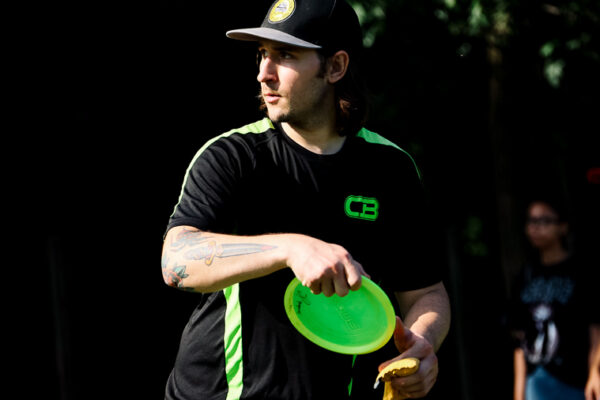Disc golf offers a rich, rewarding experience that encompasses far more than meets the eye. Central to this thrill is the continual pursuit of mastery over disc flight paths. This mastery extends to numerous shot types, each of which has its unique place in a player’s repertoire. Among these, the turnover shot stands out. It’s not just a throw; it’s an essential skill that can transform your game.
The Intricacies of a Turnover Shot
The turnover shot is an exceptional tool in the arsenal of a disc golf player. This shot type enables the disc to deviate from its natural fade direction, carving out a pathway opposite to it. The achievement of a successful turnover shot is considered a milestone in a player’s progress, a testament to their growing skill and understanding of disc golf.
A closer examination reveals that the turnover shot is not a monolithic concept but rather an umbrella term for an array of shot shapes and execution techniques. The richness and diversity within the turnover shot category add an exciting dimension to disc golf, turning it into an immersive blend of fun and learning.
The Anhyzer S-turn: A Comprehensive Breakdown
Let’s begin our exploration of turnover shots with the Anhyzer S-turn. Named after the ‘S’ pattern it traces during flight, the S-turn represents a significant leap for disc golf players. Once mastered, it unlocks a host of possibilities and strategies on the disc golf course.
Unpacking the S-Turn
An S-turn shot starts by deviating in one direction, then switches to the other direction as it completes its flight. If you’ve played disc golf, there’s a high probability you’ve executed an S-turn, knowingly or unknowingly. The beauty of an S-turn lies in its versatility—it’s as effective for shots designed to curve in a single direction throughout their flight as it is for those needing a change in direction.
But that’s not all. The S-turn is also a handy tool to optimize your disc’s airtime. As the disc traverses the ‘S’ path, it spends more time in the air, allowing for a greater travel distance.
The Science Behind the Anhyzer Release
To throw an Anhyzer S-turn, a player must understand and execute the correct nose angle. The disc should not only resist its natural fade tendency but must also curve in the opposite direction. An effective way to visualize the nose angle is by imagining your hands on a steering wheel. If you’re turning left, your left hand drops lower, mimicking the hyzer release. A right turn recreates the anhyzer release angle.
For a right-handed backhand (RHBH) player attempting an Anhyzer S-turn, the shot begins by curving to the right before fading back to the left. This technique is instrumental when the player needs to avoid early obstacles on the right and can’t allow the disc to finish in that direction due to certain factors.
The Crucial Role of Practice and Disc Knowledge
Successful execution of an Anhyzer S-turn relies heavily on disc knowledge and release point. The disc’s behavior when thrown with a specific power and nose angle varies. A super-overstable disc might barely deviate before fading back to the hyzer angle, while an understable disc could overturn and never fade back.
Mastering the release point is another critical aspect. A low release point with a steep anhyzer nose angle might send the disc crashing into the ground before it has a chance to fade back. Usually, the release point for an Anhyzer S-turn lies at eye level or above, but it varies depending on factors such as the player’s arm speed, the disc type, and the situation at hand.
The Flip Hyzer S-Turn: Unlocking Potential
The Flip Hyzer S-turn, also known as the hyzer flip, offers a contrasting flight path to the Anhyzer S-turn. Often easier to execute due to the natural tendency for players to throw with a hyzer angle, the Flip Hyzer S-turn relies heavily on above-average arm speed. The term ‘flip hyzer’ aptly illustrates the flight path where the disc, released at a hyzer angle, gains enough speed to overcome the angle, causing the disc to turn over and drift right.
This shot’s true brilliance lies in its versatility. By adjusting the nose angle, arm speed, and release point, players can control the exact point at which the disc turns. A steeper hyzer angle will delay the turnover, while a higher arm speed will hasten it.
Key Applications of the Flip Hyzer S-Turn
While the Flip Hyzer S-turn shares some characteristics with the Anhyzer S-turn, its usage differs slightly. This shot is commonly employed in two situations:
- On long, ‘tunnel’ type holes where the disc must finish on a turnover line, a flip hyzer helps maximize the distance before the disc starts to turn over.
- On wide-open holes where distance is the only concern, a properly executed Flip Hyzer S-turn delivers optimal results.
Regardless of the shot type, practice remains the key to mastering disc golf techniques. Through repetition and exploration, players can develop the confidence to use these techniques in more technical situations.
Holding the Line: The Power of Spin
Achieving a straight shot in disc golf is often more challenging than executing a turnover. Thus, it’s no surprise that making a disc hold a specific line once it has turned can prove even more daunting. However, the ability to throw a disc that turns and then follows a straight path to the end is highly valuable in scenarios where precision is crucial.
The magic ingredient that makes this possible is spin. More than just angle, speed, or trajectory, spin dictates the disc’s behavior once it turns. Increasing spin and nose angle steepness in proportion to the distance the disc needs to cover on the straight finishing line is key to this technique.
Understanding the intricacies of turnover shots, from the Anhyzer and Flip Hyzer S-turns to holding the line, can truly elevate your disc golf game. The journey toward mastering these techniques is a fulfilling path laden with discovery, improvement, and, most importantly, fun.
Make sure to checkout my article on what a roller is in disc golf next!



